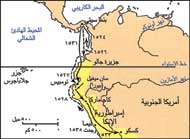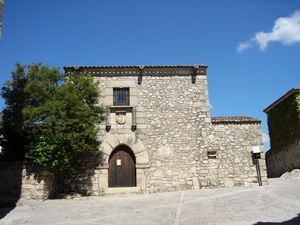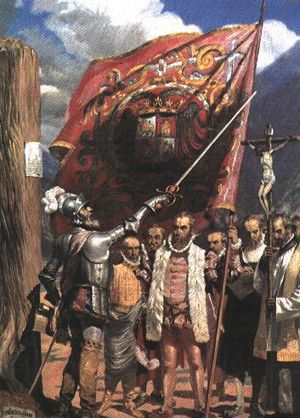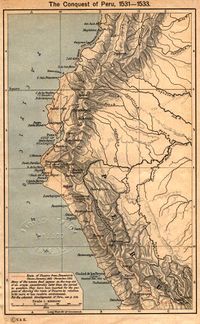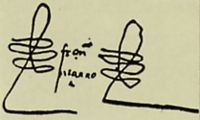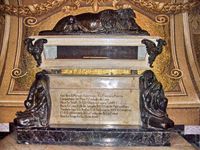فرانشسكو پيزارو
فرانسيسكو پيسارو Francisco Pizarro | |
|---|---|
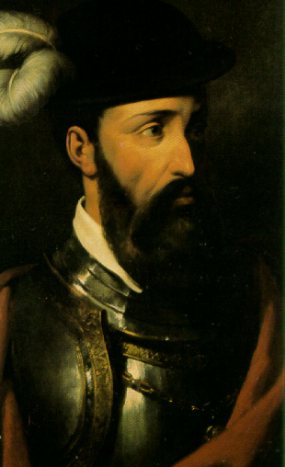 Portrait of Francisco Pizarro by Amable-Paul Coutan, 1835 | |
| وُلِدَ | ح. 16 مارس 1478 |
| توفي | 26 يونيو 1541 |
| القومية | أسباني |
| المهنة | كونكيستادور |
| عـُرِف بـ | فتح أمريكا الجنوبية |
| اللاحق | Cristóbal Vaca de Castro |
| الزوج | Inés Huaylas Yupanqui |
| الأنجال | Francisca Pizarro Yupanqui |
| التوقيع | |
 | |
فرانسيسكو پيسارو گونزاليز، ماركيز أتابيوس ( Francisco Pizarro ؛ /pɪˈzɑːroʊ/؛ النطق الإسپاني: [fɾanˈθisko piˈθaro]؛ ح. 16 مارس 1478 - 26 يونيو 1541)، كونكيستادور (غازي) اسباني. اشتهر بتجريدته التي أدت إلى الفتح الاسباني لبيرو.
Born in Trujillo, Spain to a poor family, Pizarro chose to pursue fortune and adventure in the New World. He went to the Gulf of Urabá, and accompanied Vasco Núñez de Balboa in his crossing of the Isthmus of Panama, where they became the first Europeans to see the Pacific Ocean from the Americas. He served as mayor of the newly founded Panama City for a few years and undertook two failed expeditions to Peru. In 1529, Pizarro obtained permission from the Spanish crown to lead a campaign to conquer Peru and went on his third, and successful, expedition.
When local people who lived along the coast resisted this invasion, Pizarro moved inland and founded the first Spanish settlement in Peru, San Miguel de Piura. After a series of manoeuvres, Pizarro captured the Incan emperor Atahualpa at the Battle of Cajamarca in November 1532. A ransom for the emperor's release was demanded and Atahualpa filled a room with gold, but Pizarro charged him with various crimes and executed him in July 1533. The same year, Pizarro entered the Inca capital of Cuzco and completed his conquest of Peru. In January 1535, he founded the city of Lima. Pizarro eventually fell victim to political power struggles and was assassinated in 1541.[2]
فتحت انتصاراته على إمبراطورية الإنكا في بيرو الطريق أمام أسبانيا لاستعمار أغلب أمريكا الجنوبية.
النشأة
وُلِدَ بيزارو في تروهيو، بأسبانيا، وكان والده قائدًا ملكيّا لكتيبة مشاة. وهو ابن غير شرعي، قام أقارب والدته الفقراء بتربيته، لذلك لم يتعلم القراءة أبدًا. في عام 1502م ذهب بيزارو إلى جزر الهند الغربية. عاش في هسبانيولا، القاعدة الأسبانية الرئيسية في العالم الجديد. وربما تلقى المساعدة من عمه الذي كان يقيم بجزر الهند الغربية.
الحملات الأولى
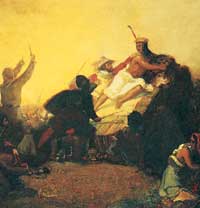
غادر بيزارو هسبانيولا عام 1509م للاشتراك في اكتشاف الساحل الكاريبي لشمالي أمريكا الجنوبية وجنوبي أمريكا الوسطى. خدم لدى ڤاسكو نونيز دي بالبوا رئيس مُلازمين عندما زحف بالبوا عبر مضيق بنما إلى المحيط الهادئ عام 1513م. بعد ست سنوات أسس الأسبانيون مدينة بنما على ساحل المحيط الهادئ. كان بيزارو من أغنى أغنيائها ومن أصحاب السلطة فيها. وأصبح الأسبانيون في بنما مهتمين بالتقارير التي تردهم عن إمبراطورية غنية للهنود تقع إلى الجنوب. في عام 1524م، بدأ بيزارو الحملة الأولى ضمن مجموعة حملات للبحث عن هذه الإمبراطورية.
ساعد بيزارو أسباني آخر، يدعى دييجو دي ألماجرو، خدم بصفة أساسية مديرًا لأعمال الحملة. قاد بيزارو الحملة جنوبي ساحل المحيط الهادئ. في البداية أعاقت هجمات الهنود ورداءة الطقس البحارة عن اكتشاف الإمبراطورية التي كانت تتمركز فيما يُدعى الآن بيرو. وصل بيزارو أخيرًا إلى هدفه عام 1527م أو أوائل 1528م.
تسليم توليدو
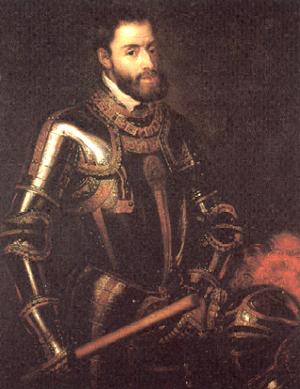
When the new governor of Panama, Pedro de los Ríos, refused to allow for a third expedition to the south, the associates resolved for Pizarro to leave for Spain and appeal to the sovereign in person. Pizarro sailed from Panama for Spain in the spring of 1528, accompanied by Pedro de Candia, some natives and llamas, plus samples of fabric, gold and silver.[3]
Pizarro reached Seville in early summer. King Charles I, who was at Toledo, had an interview with Pizarro and heard of his expeditions in South America. The conquistador described the territory as rich in gold and silver that he and his followers had bravely explored "to extend the empire of Castile". The king, who was soon to leave for Italy, was impressed at his accounts and promised his support for the conquest of Peru. Queen Isabel, though, in the absence of the king, signed the Capitulación de Toledo on 6 July 1529,[4] a license document that authorized Pizarro to proceed with the conquest of Peru. Pizarro was officially named the Governor, Captain general, Adelantado and Alguacil Mayor, of New Castile for the distance of 200 leagues along the newly discovered coast and invested with all authority and prerogatives, leaving his associates in secondary positions (a fact that later incensed Almagro and would lead to eventual discord). One of the grant conditions was that within six months, Pizarro should raise a sufficiently equipped force of 250 men, of whom 100 might be drawn from the colonies.[3]
This gave Pizarro time to leave for his native Trujillo and convince his brother Hernando Pizarro and other close friends to join him on his third expedition.[3] Francisco de Orellana joined the group and would later discover and explore the length of the Amazon River. Two half-brothers from his father, Juan Pizarro and Gonzalo Pizarro,[5] and a half-brother from his mother, Francisco Martín de Alcántara,[3] later also decided to join him, as well as his cousin Pedro Pizarro, who served as his page.[6] When the expedition left the following year, it numbered three ships, 180 men and 27 horses.[3]
Pizarro could not raise the number of men the Capitulación required and sailed clandestinely from the port of Sanlúcar de Barrameda for the Canary Island of La Gomera in January 1530. He was there joined by his brother Hernando and the remaining men in two vessels that would sail back to Panama.[3] Pizarro's third and final expedition left Panama for Peru on 27 December 1530.[5]
احتلال بيرو
رأى بيزارو دليلاً أكيدًا على وجود الذهب والثروات الأخرى في بيرو. فعاد على الفور إلى أسبانيا، وعيّنه الملك شارلز الأول حاكمًا على بيرو. في عام 1531م، أبحر بيزارو من مدينة بنما ومعه نحو 180 رجلاً. ونزلوا فيما يُسمَّى الآن الإكوادور عام 1532م، أسسوا سان ميگيل (الآن بيورا) في شمالي بيرو. بعدها زحف بيزارو إلى كاجاماركا، حيث جمع حاكم الإنكا أتاهوالبا قواته. وفي هجوم مفاجئ بالسيوف والخيول وقليل من البنادق أمسك رجال بيزارو بأتاهوالبا وقتلوا الآلاف من الإنكا. وتعهد الأسبان بالإبقاء على حياة أتاهوالبا في مقابل الثروات الضخمة. ووافقت الإنكا على الفدية لأن بيرو كانت غنية بالذهب والفضة أكثر من أي مكان آخر في أمريكا. ولكن في عام 1533م، بعد تسلمهم كنزًا ضخمًا، أعدم الأسبان أتاهوالبا. بعدها تقدم بيزارو جنوبًا إلى كسكو ، العاصمة الجبلية للإنكا. واستولى الغزاة على المدينة أواخر عام 1533م.
أواخر حياته
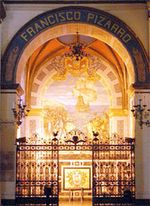
في عام 1535م، أسس بيزارو مدينة ليما وجعلها عاصمة بيرو. عندما كان حاكمًا لبيرو، استوطنها الكثير من الأسبان. بدأ المستوطنون في تعدين الذهب والفضة وشرعوا في بناء عدة مدن.
استخدمت أسبانيا بيرو قاعدة لاستكمال فتوحاتها لأغلب ما تبقَّى من أمريكا الجنوبية.
في أواخر الثلاثينيات من القرن السادس عشر الميلادي، نشأ نزاع بين بيزارو وألماجرو حول حكم المنطقة التي تقع حول كسكو مما أدى إلى نشوب الحرب بينهما، نجحت قوات بيزارو في عام 1538م، وقامت بإعدام ألماجرو. في عام 1541م، قام أنصار أبناء ألماجرو بقتل بيزارو.
ذكرى بيسارو
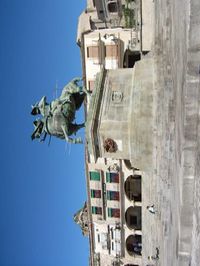
أجداده
أعمال پيسارو
- Cartas del Marques Don Francisco Pizarro (1533-1541)
- Cédula de encomienda de Francisco Pizarro a Diego Maldonado, Cuzco, 15 de abril de 1539
| مناصب حكومية | ||
|---|---|---|
| سبقه منصب مستحدث |
Governor of New Castile 1528 - 1541 |
تبعه Cristóbal Vaca de Castro |
انظر أيضاً
- إنكا
- بيرو
- Battle of Punta Quemada
- معركة پونا
- Battle of Cajamarca
- Francisco de Orellana
- الاستعمار الاسباني للأمريكتين
الهامش
- ^ Cúneo-Vidal, R.: «Los hijos americanos de los Pizarros de la conquista.»
- ^ "Francisco Pizarro | Biography, Accomplishments, & Facts | Britannica". www.britannica.com (in الإنجليزية). Retrieved 10 April 2022.
- ^ أ ب ت ث ج ح خطأ استشهاد: وسم
<ref>غير صحيح؛ لا نص تم توفيره للمراجع المسماةPrescott - ^ "college.hmco.com".
- ^ أ ب خطأ استشهاد: وسم
<ref>غير صحيح؛ لا نص تم توفيره للمراجع المسماةHemming - ^ Pizzaro, P. (1571). Relation of the Discovery and Conquest of the Kingdoms of Peru, Vol. 1–2, New York: Cortes Society, RareBooksClub.com, ISBN 978-1235937859
- ^ GeneAll.net - Francisco Pizarro
المصادر
- "Cajamarca o la Leyenda Negra" a Tragedy for the Theater in Spanish by Santiago Sevilla in Liceus El Portal de las Humanidades [1]
- "Pizarro", a tragedy, by Richard Brinsley Sheridan, in Google books [2]
- Conquest of the Incas, John Hemming, 1973. ISBN 0-15-602826-3
- Francisco Pizarro and the Conquést of the Inca by Gina DeAngelis, 2000. ISBN 0-613-32584-2
- The Discovery and Conquest of Peru by William H. Prescott ISBN 0-7607-6137-X
وصلات خارجية
- Franciso Pizarro, Catholic Encyclopedia (1911)
- PBS Special: Conquistadors — Pizarro and the conquest of the Incas
- Francisco Pizarro, a Head of His Time
- The Conquest of the Incas by Pizarro - UC Press
- The European Voyages of Exploration
- Works by or about فرانشسكو پيزارو in libraries (WorldCat catalog)
- "Francisco Pizarro," February 1992, National Geographic
| مناصب حكومية | ||
|---|---|---|
| سبقه Position founded |
Governor of New Castile 1528–1541 |
تبعه Cristóbal Vaca de Castro |
- Short description is different from Wikidata
- Biography with signature
- Pages using infobox person with conflicting parameters
- Articles with hatnote templates targeting a nonexistent page
- Articles with redirect hatnotes needing review
- مواليد عقد 1470
- وفيات 1541
- إسپان من القرن 16
- نبلاء اسبان
- تاريخ پيرو
- مؤسسو مدن
- كونكيستادورات إكسترمادوريون
- مدفونون في كاتدرائية ليمان
- أشخاص قتلوا في بيرو
- Assassinated Spanish people
- اسبان قتلوا في الخارج
